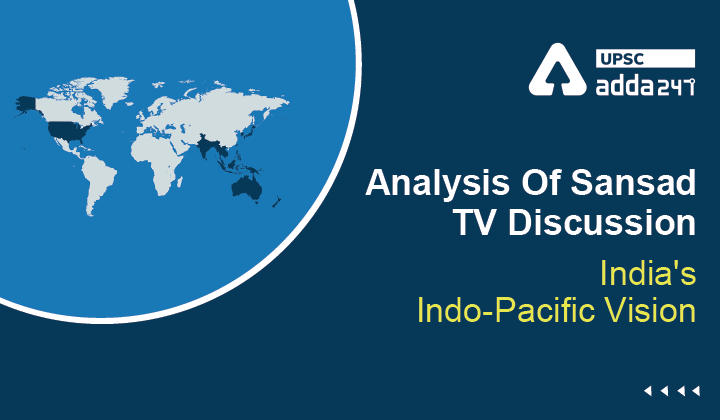Table of Contents
Analysis Of Sansad TV Discussion
”India’s Indo-Pacific Vision”
Relevance
”GS 2: India and its Neighbourhood, Groupings & Agreements Involving India and/or Affecting India’s Interests”
Context
US President Joe Biden’s recent Indo-Pacific strategy document gives a clear indication of the value the US places on its strategic partnership with India and its vision for New Delhi to play a central role in this vital region that is increasingly subject to Chinese aggression and coercion.
About Indo-Pacific
- The Indo-Pacific region is a vast maritime zone where the interests of many players are engaged: India, Japan, France, and the United States, as well as medium and smaller powers like Australia, Indonesia, and South Africa; there are stakeholders from beyond the region, too.
- In recent years, uncertainty has heightened in the region owing to China’s territorial expansionist agenda, concerns for the United States’ long-term commitment to Asia, as well as the limitations of existing multilateral institutions.
- A large part of global trade flows through the Indian Ocean Region. A significant portion of our trade and energy needs are met through the oceans. Safety of the seas and of the maritime commons, therefore, remains a critical requirement.
- The importance of the Indo-Pacific region to global GDP and maritime trade reflects a shift in the world economic centre of gravity to the Indo-Pacific.
- Indeed, the Indo-Pacific is emerging as the new and expanded theatre of great-power contestation.
India’s Indo-Pacific strategy
- It walks on two legs — strengthening its national engagement with the region, and stronger partnerships with like-minded nations.
- The former elevates India’s salience in the Indo-Pacific and raises Delhi’s value for its partners.
- Coalitions and partnerships, in turn, help boost India’s national capabilities, and enhance its reach and impact.
- This approach is quite different from the metaphysics of the past that focused on the presumed need to hold up a particular ideology rather than a hard-headed pursuit of national interests.
India’s Engagement with the Indo-Pacific
- India’s engagement with the Indo-Pacific goes back several centuries.
- India has been championing the Free and Open Indo-Pacific(FOIP) idea and initiating forums like the Security and Growth for All in the Region (SAGAR) and the Indo-Pacific Oceans Initiative (IPOI).
- India engages with its Indo-Pacific partners either bilaterally, or on plurilateral and multilateral platforms, in a multitude of spheres including maritime security, Blue Economy, maritime connectivity, disaster management, and capacity building.
- Strengthening engagement with the region, and stronger partnerships can enhance India’s reach and impact.
About the Indo-Pacific Maritime Cooperation
- The major focus of the Indo-Pacific is based on oceans, which is the common thread that connects all.
- Countries including India, Indonesia, Singapore, and Sri Lanka, primarily maritime nations occupy the most important strategic positions in the Indian Ocean.
- To promote its strategic interests in the Indian Ocean, India launched the Security and Growth for All in the Region (SAGAR vision) in 2015.
- The Indian government believes in an Indo-Pacific that is free, open and inclusive, and one that is founded upon a cooperative and collaborative rules-based order.
About the Indo-Pacific Oceans Initiative
The Indo-Pacific Oceans Initiative (IPOI), announced by Prime Minister Narendra Modi at the 14th East Asia Summit on 4 November 2019 at Bangkok, has seven pillars:
- Maritime Ecology
- Maritime Security
- Marine Resources
- Capacity Building and Resource Sharing
- Disaster Risk Reduction and Management
- Science, Technology and Academic Cooperation
- Trade, Connectivity and Maritime Transport.



 TSPSC Group 1 Question Paper 2024, Downl...
TSPSC Group 1 Question Paper 2024, Downl...
 TSPSC Group 1 Answer key 2024 Out, Downl...
TSPSC Group 1 Answer key 2024 Out, Downl...
 UPSC Prelims 2024 Question Paper, Downlo...
UPSC Prelims 2024 Question Paper, Downlo...




